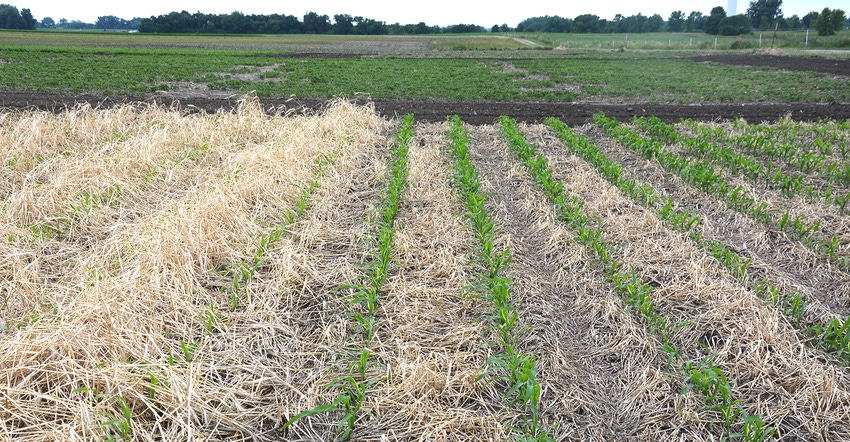
Some farmers interested in cover crops have planted soybeans into cereal rye or winter wheat, had good results with weed suppression and experienced negligible yield impacts.
However, no research data is available about planting corn into living cereal rye, says Abbey Wick, North Dakota State University assistant professor of soil health. At a small research plot at the West Central Research and Outreach Center in Morris, scientists are evaluating corn planted into rye, both alive and terminated. Wick, along with Dave Franzen, a NDSU Extension soil scientist, and Curt Reese, a WCROC scientist, talked about their work at a soil health field day held in late June.

TEASING TERMINATOR: Dave Franzen, a North Dakota State University Extension soil scientist, added some humor to his presentation on terminating rye by donning a black cape and carrying a toy scythe.

Reese explained that the field was disk-chiseled with a DMI and winter rye was planted with a 750 John Deere no-till planter in late October 2016. This spring, all corn in the plot was planted June 2. The goal was to spray the rye one week before planting, at planting and a week after planting. However, herbicide spraying times varied due to workload and rain. The rye was sprayed with Roundup Powermax at 22 ounces per acre on April 17, May 25 and June 5. Reese estimated rye growth for the sprayed strips as 6 inches, 10 inches and 16 inches tall, respectively. Plus, a strip of rye was left to grow.
Although some farmers are experimenting with corn planted into green rye, Wick says she does not recommend the practice for this region until researchers know more about the potential yield response of corn.
“Farmers are toying around with planting corn directly into a living cereal rye,” Wick says. “There is research against this practice from other states, showing hits to yields. I haven't done any of this work specifically, but have seen stunted corn in side-by-side strips on multiple farms where corn was planted into rye and non-rye.”
She explained that farmers are "planting green" for different reasons — for weed control, to reduce soil loss from erosion, to improve traffic on wet soils and to build soil health.
However, Wick cautions farmers to consider a few things before trying it. First, the practice is not a Risk Management Agency-approved crop cover approach. Second, in a dry year, cereal rye can be a water hog and use more moisture than you want. And third, pest issues may occur due to a change in the soil environment, making it more habitable.
Plus, corn growth — as well as weed growth — may be inhibited by rye due to allelopathy. Other Midwest researchers have noted that while rye produces chemicals that can inhibit plant growth, under most situations the researchers say soil surface rye biomass is responsible for suppression of weeds. They also think the chemicals produced by rye probably have little influence on corn growth. Their research has shown that susceptibility to allelopathy is indirectly related to seed size. The smaller the seed, the more susceptible the plant.
Franzen says they are hearing a lot of anecdotal evidence regarding rye cover crop practices.
“We’re trying to put some numbers to them, but there isn’t a scientific approach to it yet,” he says. Research and collaborative projects continue.
When to terminate and how
Cover crop termination could be chemical or mechanical, the researchers explained at the field day. Wick says using full rates of Round Up or crimpers would do the job. She notes that rye could need to be hit three times with a crimper to be terminated. Reese adds that rye needs to have reached the anthesis stage in order to be effectively killed by crimping.
“I prefer chemical termination,” Wick adds.
According to RMA guidelines, a cover crop prior to corn should be terminated 10 to 14 days prior to planting for most of Minnesota and all of the Dakotas. If federal program rules don’t apply to your operation, Reese suggests terminating at least seven to 10 days before corn planting.
Concludes Wick: “Our job as researchers and Extension specialists is to follow the data. In the case of corn into a living cereal rye cover crop, the data tell us it's a bad idea.”
For more information on seeding into rye, read U-M's Winter Wheat and Winter Rye and NDSU's Soil Health and Land Management.
For more on soil health in general, visit ndsu.edu/soilhealth.
About the Author(s)
You May Also Like






